Microsoft Bundle
How Does Microsoft Dominate the Tech World?
From its humble beginnings in 1975, Microsoft has transformed from a software provider to a global tech titan. The company's journey, marked by pivotal deals like the one with IBM, laid the foundation for its current dominance. With over $245 billion in annual revenue in fiscal year 2024, how does Microsoft maintain its leading position in the ever-evolving tech landscape?
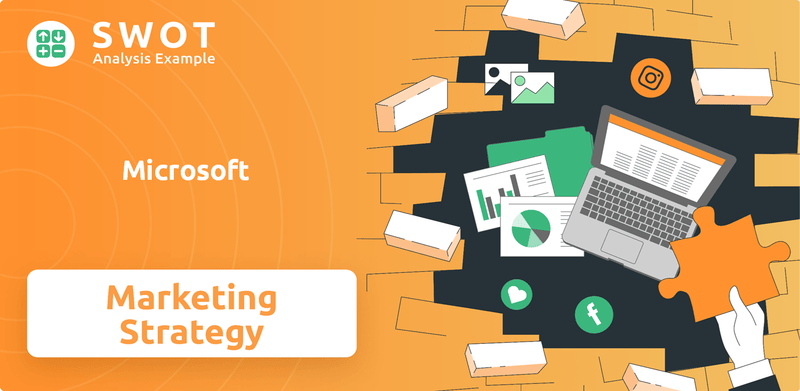
This analysis delves into the Microsoft SWOT Analysis, exploring how Microsoft's sales and marketing strategies have evolved. We'll uncover the core elements of Microsoft's sales strategy and marketing strategy, examining its go-to-market approach, digital marketing approach, and the impact of its marketing campaigns examples. Understanding Microsoft's business model, market share, and competitive analysis is key to appreciating its sustained success and future prospects, including how it generates sales.
How Does Microsoft Reach Its Customers?
The sales channels of Microsoft are diverse, utilizing both online and offline methods to reach its wide customer base. This comprehensive approach includes e-commerce platforms, the company website, direct sales teams, wholesale distributors, and partner retailers. The aim is to cover all possible avenues for product distribution and customer engagement.
Microsoft's sales strategy has evolved significantly, especially with the rise of cloud computing and, more recently, artificial intelligence. The company is adapting its go-to-market strategies to align with technological advancements, ensuring it remains competitive in the ever-changing tech landscape. This includes a strategic shift towards leveraging third-party partners for sales to small and mid-size customers, a move that began with enhanced incentives for these partners in November 2024.
The company's in-house sales teams are focused on offering a wider range of products, increasingly emphasizing AI solutions. They are also providing additional technical training for employees. This shift reflects a broader trend in the AI era. The Sales Hub app, crucial for sales professionals, is transitioning from a semiannual release channel to a monthly release channel in 2024 wave 2, ensuring faster access to new features and continuous workflow improvement.
Microsoft utilizes its own e-commerce platforms and company website as primary sales channels. These platforms offer direct access to products and services, allowing for a streamlined purchasing experience. This direct-to-consumer approach is crucial for maintaining control over the customer journey and gathering valuable data.
Direct sales teams focus on enterprise clients and complex solutions. They provide personalized service and support, which is crucial for closing large deals and building strong customer relationships. These teams are often specialized by product or industry.
Microsoft partners with wholesale distributors to reach a wider audience, particularly for hardware and software products. This channel allows the company to scale its distribution network efficiently. Distributors handle logistics and sales to various retailers and resellers.
Partner retailers, including both online and brick-and-mortar stores, are essential for product visibility and accessibility. These partnerships provide customers with various purchasing options and support services. This strategy is vital for reaching a broad consumer base.
Microsoft's sales and marketing efforts are significantly enhanced through strategic partnerships. These collaborations expand the reach and appeal of its offerings. For example, partnerships with companies like Adobe and SAP integrate Microsoft products into broader ecosystems.
- Collaborations with other technology firms, developers, and industry leaders create synergies and expand market reach.
- Microsoft is urging its Business Applications partners to invest in selling in product areas and market segments that Microsoft aims to strengthen in fiscal year 2025.
- This multi-year effort focuses on solution designations and specializations for partners, ensuring adequate capacity to service demand.
- Exclusive distribution deals also play a role in expanding Microsoft's market share.
Microsoft SWOT Analysis
- Complete SWOT Breakdown
- Fully Customizable
- Editable in Excel & Word
- Professional Formatting
- Investor-Ready Format
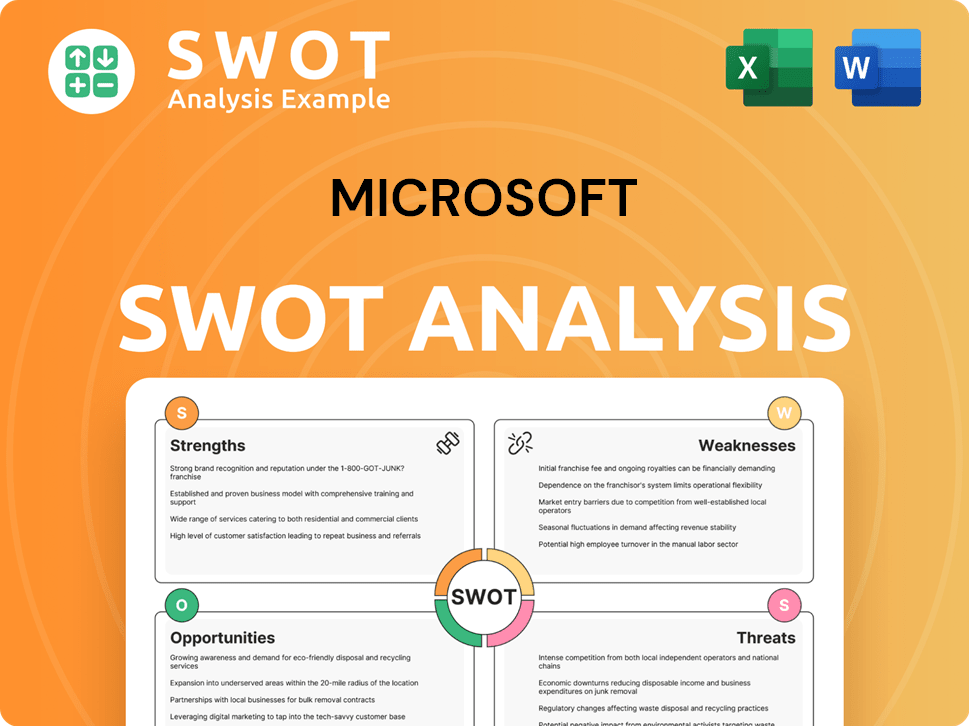
What Marketing Tactics Does Microsoft Use?
Microsoft employs a multifaceted approach to sales and marketing, leveraging a blend of digital and traditional tactics to build brand awareness and drive revenue. This comprehensive strategy includes a strong focus on digital marketing, data-driven insights, and customer-centric campaigns. The company's marketing efforts are designed to generate leads and boost sales across its diverse product and service offerings.
The company's digital strategy is extensive, incorporating various channels and techniques. Microsoft uses content marketing, SEO optimization, paid advertising, email marketing, influencer partnerships, and social media platforms. This integrated approach allows Microsoft to reach a wide audience and engage with potential customers across multiple touchpoints.
A core element of Microsoft's strategy is its use of data-driven marketing, customer segmentation, and personalization. The company leverages analytics to target digital ads, measure brand sentiment, and tailor campaigns for maximum impact. This data-driven approach helps Microsoft optimize its marketing spend and improve customer engagement.
Microsoft's digital marketing strategy is extensive, incorporating content marketing, SEO, paid advertising, and social media. The company leverages its own advertising platforms like Bing Ads and Microsoft Advertising. This approach allows for broad reach and targeted engagement.
Microsoft uses data analytics to target digital ads and tailor marketing campaigns for specific customer segments. Segmentation, Targeting, and Positioning (STP) marketing are key to customizing solutions. This approach ensures that marketing efforts are efficient and effective.
AI is central to Microsoft's marketing strategy, with platforms like Copilot playing a crucial role. Copilot assists with automating content creation, analyzing campaign performance, and personalizing customer communications. This integration enhances efficiency and personalization.
Microsoft emphasizes cross-promotion across its product ecosystem, turning single product entries into gateways for multiple products. For example, Teams usage during the pandemic was leveraged to promote other tools like Word and Excel.
Microsoft balances performance marketing with long-term brand building, promoting messages of accessibility, sustainability, and social good. This approach ensures a strong brand image while driving sales.
Microsoft Ads offers a cost-effective way to acquire targeted traffic, with cost-per-click often 30-50% lower than Google Ads. In 2024, Microsoft Ads generated $12.58 billion from search ads. This provides a significant advantage in digital advertising.
Microsoft's marketing tactics include a comprehensive array of digital and traditional approaches. The company focuses on building awareness, generating leads, and driving sales through various channels.
- Content Marketing: Creating valuable content to attract and engage the target audience.
- SEO Optimization: Improving search engine rankings to increase visibility.
- Paid Advertising: Utilizing platforms like Bing Ads and programmatic advertising.
- Email Marketing: Sending targeted emails to nurture leads and drive conversions.
- Influencer Partnerships: Collaborating with influencers to reach new audiences.
- Social Media: Leveraging social media platforms for brand promotion and customer engagement.
The company's integrated approach, combined with its focus on data and AI, ensures that its marketing efforts are both effective and adaptable to changing market conditions. For more detailed insights, explore Revenue Streams & Business Model of Microsoft.
Microsoft PESTLE Analysis
- Covers All 6 PESTLE Categories
- No Research Needed – Save Hours of Work
- Built by Experts, Trusted by Consultants
- Instant Download, Ready to Use
- 100% Editable, Fully Customizable
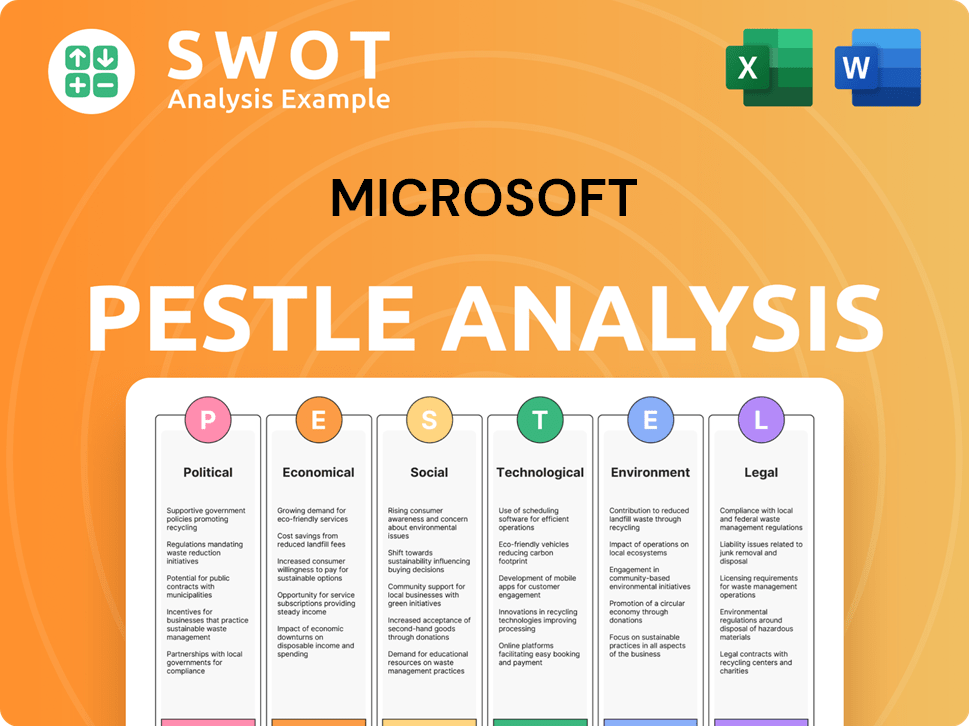
How Is Microsoft Positioned in the Market?
The brand positioning of Microsoft centers on empowering individuals and organizations globally, a mission that shapes its sales and marketing strategies. This positions the company as a facilitator of human potential through technological innovation. Microsoft differentiates itself by emphasizing integration, accessibility, and value creation, catering to a diverse audience.
Microsoft's core message revolves around enabling achievement through innovation, consistently highlighting how its products, from cloud services to gaming, enhance user capabilities. This approach builds an emotional connection with customers, fostering loyalty. The brand's visual identity and messaging consistently reflect clarity, reliability, and approachability, reinforcing its commitment to user-friendly experiences.
Microsoft's brand identity is reinforced through consistent messaging across all channels, from B2B marketing to consumer-focused campaigns. This consistency builds trust and reinforces the company's values. The company's focus on innovation, reliability, and user-friendly experiences is key to its market success.
Microsoft's brand positioning is deeply rooted in its mission to empower every person and organization on the planet. This mission guides its branding efforts and establishes an emotional connection with customers. The company's focus on innovation and user empowerment is central to its sales and marketing strategies.
Microsoft differentiates itself from competitors through a balance of scale and personalization. It emphasizes integration, accessibility, and value creation in its products and services. This approach helps Microsoft maintain a strong market share and competitive advantage.
The core message of Microsoft revolves around empowerment through innovation. The company consistently highlights how its diverse products, from Azure cloud services to Xbox gaming, enable human potential. This messaging strategy is key to its marketing campaigns examples.
Microsoft's visual identity, characterized by a distinctive logo and a clean, modern color palette, signifies clarity and innovation. The brand personality exudes reliability, knowledge, and approachability, which enhances customer trust and brand recognition.
Microsoft's brand positioning strategy involves several key elements that contribute to its market success. These elements are crucial for understanding how Microsoft generates sales and maintains its competitive edge. The company's approach to its sales process overview is also a key factor.
- Innovation: Microsoft consistently introduces new technologies and features to stay ahead of the competition.
- Reliability: The company emphasizes the dependability of its products and services to build customer trust.
- User-Friendly Experiences: Microsoft focuses on creating intuitive and accessible products for a broad audience.
- Ethical Practices: The company's commitment to integrity, honesty, and respect fosters trust among customers and stakeholders.
Microsoft Business Model Canvas
- Complete 9-Block Business Model Canvas
- Effortlessly Communicate Your Business Strategy
- Investor-Ready BMC Format
- 100% Editable and Customizable
- Clear and Structured Layout
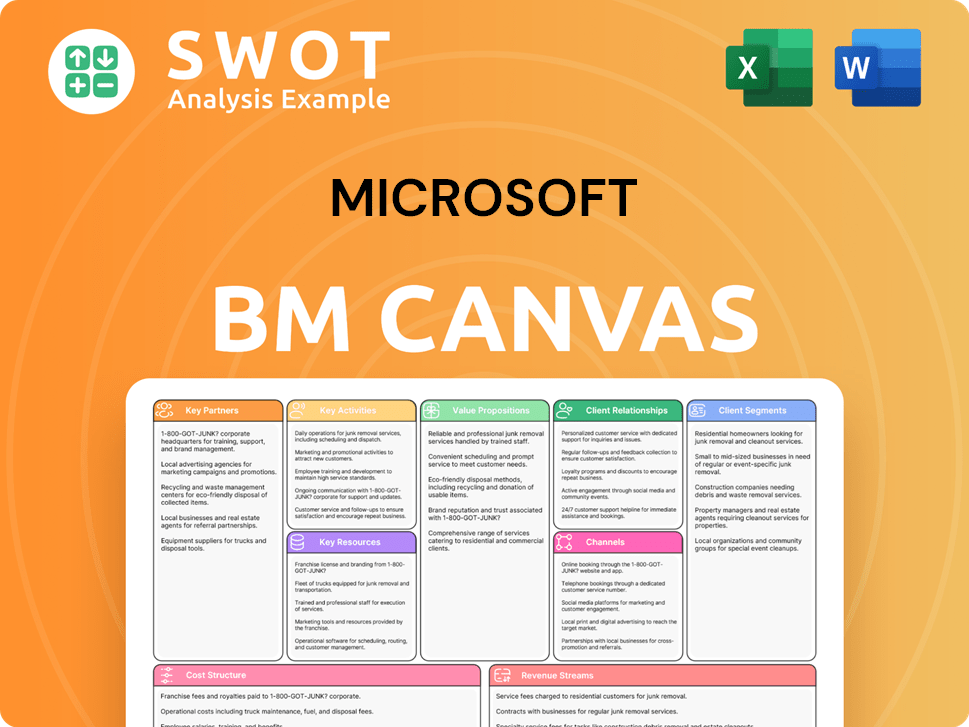
What Are Microsoft’s Most Notable Campaigns?
The core of recent Microsoft's marketing campaigns revolves around the integration of AI, particularly focusing on the 'Copilot' initiative. This approach highlights AI as an essential tool, integrated across various products like Office, GitHub, and Windows. Marketing efforts spotlight real-world user experiences, showcasing how Copilot enhances productivity and streamlines tasks for users.
A key objective is to drive AI adoption across its entire product range, aiming for 'Copilots on every device across every role' and 'AI design wins with every customer.' This strategy is evident in the enhanced incentives for third-party partners introduced in November 2024, reflecting a shift in sales tactics to meet evolving customer needs in the AI era. Furthermore, the company is investing in educational programs to make its products accessible to students and educators, fostering brand loyalty from a young age.
The company's focus on AI is also evident in its sales strategy, aiming to convert more leads and reduce the time spent on content creation and user insight generation. The company's marketing strategy is designed to build brand awareness and increase leads. The goal is to convert twice as many leads into opportunities and cut content creation and user insight generation time by 50%.
The 'Copilot' initiative is central to Microsoft's marketing, integrating AI across products like Office and Windows. This emphasizes AI's role as an assistive tool, improving user productivity and efficiency. The marketing showcases real user experiences, illustrating how Copilot simplifies tasks and enhances workflows.
The company aims for 'Copilots on every device' and 'AI design wins with every customer,' driving AI adoption across its portfolio. Incentives for third-party partners introduced in November 2024 support this shift. Educational programs are also in place to encourage early adoption and brand loyalty.
Microsoft's financial results reflect the success of these strategies. Total revenue for fiscal year 2024 was $245.1 billion, a 16% increase from 2023. Operating income reached $109.4 billion, a 24% increase, and the Intelligent Cloud segment grew by 20% to $109.4 billion in FY24.
Despite a drop in Xbox hardware revenue, Xbox content and services revenue increased by 2%, driven by Xbox Game Pass and the Activision Blizzard acquisition. Gaming revenue for FY24 was $21.5 billion, up 39% from 2023, boosted by titles like 'Call of Duty: Black Ops 6' and 'Indiana Jones and the Great Circle'.
Microsoft 365 Copilot directly influences marketing KPIs, building brand awareness and increasing leads. The goal is to double lead-to-opportunity conversion rates. It also aims to reduce content creation time by 50%.
The Intelligent Cloud segment, including Azure, experienced substantial growth. Azure and other cloud services revenue grew by 30% in FY24. Microsoft Cloud revenue reached $42.4 billion in Q3 FY25, demonstrating the effectiveness of cloud-focused strategies.
The gaming segment saw significant revenue growth, with a 39% increase in FY24. The acquisition of Activision Blizzard and the launch of new titles like 'Call of Duty: Black Ops 6' and 'Indiana Jones and the Great Circle' contributed to this growth.
Enhanced incentives for third-party partners, introduced in November 2024, are a key part of the sales strategy. These incentives support the company's push to meet changing customer needs in the AI era. This strategy is part of Microsoft's sales process overview.
Microsoft invests in educational programs and resources to make its products accessible to students and educators. This strategy fosters brand loyalty from a young age. This approach is a part of Microsoft's target audience analysis.
Microsoft's digital marketing approach leverages social media and content marketing to boost sales. The company's content marketing strategy focuses on user stories and product demonstrations. This approach is a part of Microsoft's customer relationship management.
Microsoft Porter's Five Forces Analysis
- Covers All 5 Competitive Forces in Detail
- Structured for Consultants, Students, and Founders
- 100% Editable in Microsoft Word & Excel
- Instant Digital Download – Use Immediately
- Compatible with Mac & PC – Fully Unlocked
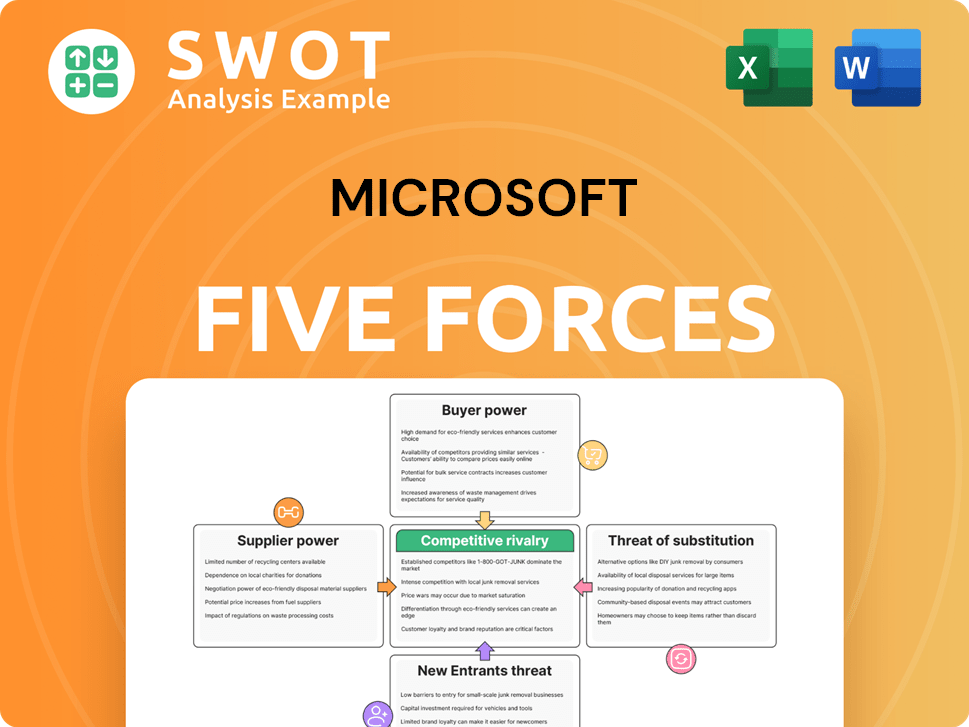
Related Blogs
- What are Mission Vision & Core Values of Microsoft Company?
- What is Competitive Landscape of Microsoft Company?
- What is Growth Strategy and Future Prospects of Microsoft Company?
- How Does Microsoft Company Work?
- What is Brief History of Microsoft Company?
- Who Owns Microsoft Company?
- What is Customer Demographics and Target Market of Microsoft Company?
Disclaimer
All information, articles, and product details provided on this website are for general informational and educational purposes only. We do not claim any ownership over, nor do we intend to infringe upon, any trademarks, copyrights, logos, brand names, or other intellectual property mentioned or depicted on this site. Such intellectual property remains the property of its respective owners, and any references here are made solely for identification or informational purposes, without implying any affiliation, endorsement, or partnership.
We make no representations or warranties, express or implied, regarding the accuracy, completeness, or suitability of any content or products presented. Nothing on this website should be construed as legal, tax, investment, financial, medical, or other professional advice. In addition, no part of this site—including articles or product references—constitutes a solicitation, recommendation, endorsement, advertisement, or offer to buy or sell any securities, franchises, or other financial instruments, particularly in jurisdictions where such activity would be unlawful.
All content is of a general nature and may not address the specific circumstances of any individual or entity. It is not a substitute for professional advice or services. Any actions you take based on the information provided here are strictly at your own risk. You accept full responsibility for any decisions or outcomes arising from your use of this website and agree to release us from any liability in connection with your use of, or reliance upon, the content or products found herein.